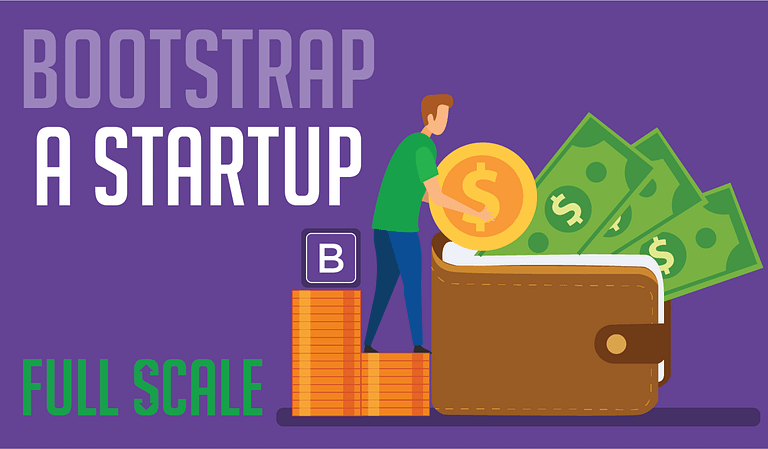In the world of business, aspiring entrepreneurs have several funding options to kick off their operations. However, with all the hype given to venture capitalists, a lot of business minds neglect the basic and simplest options for funding…bootstrapping.
To most people, DIY-ing the funding aspect of a startup is incredibly daunting. Paving your way to success is no easy task. And just like in any DIY project, you are accountable for whatever the outcome may be. But, if you do it properly, you might find yourself reaping all the benefits of what you planted alone.
Contrary to popular belief, a lot of startup unicorns got started with little to no amount of support from investors. There is an impressive list of companies that have made it with no outside help. But of course, it’s still a case-to-case basis whether bootstrapping is ideal for a startup.
In this entry, we’ll explore the dynamics of how to bootstrap a startup.
What is Bootstrapping?

So, what is bootstrapping in a business context?
It is the act of funding your business from your pocket. The term “bootstrap” is a noun that refers to a startup running with no funding aid. It was coined from the expression “pulling up by one’s own bootstraps,” which is a metaphor for pursuing an impossible feat.
To be clear, bootstrapping doesn’t mean going at it completely alone for the entire journey. It usually happens in the initial startup stage. When you think about it, only a few of the investors are willing to gamble on a company that hasn’t created much traction. Bootstrapping is one way to entice those sponsors to put in the money.
But, can you really go far by using your own resources?
Yes, a lot of big names in the tech industry (Apple, Dell Computer, and Microsoft) started as boot-strapped ventures. These business owners took advantage of the unlimited control and independence that bootstrapping has to offer.
When you’re not relying on outside sources for funding, you can take full ownership of the equity. However, this great opportunity also comes with a great risk of losses. So, if you’re considering this approach for your business, let’s first understand how it works and see if it’s a good option.
How to Bootstrap a Startup
The bootstrapping method goes through three funding stages: beginning stage, customer-funded stage, and credit stage. To begin, let’s break down the requirements for each stage.
Beginning Stage
As the name suggests, it’s the beginning of a startup. This stage entails taking out money from your savings to kick off your operations. Some startup owners, at this point, choose to keep their day jobs to secure the cash flow. This stage involves buying essential equipment, assembling your team (unless you’re winging it solo), and making your presence known to your target market.
Customer-funded Stage
Once you’ve got the ball rolling, it’s your customers that will keep your operations going. In this stage, whatever money you’ve made in sales will fund your operations and eventually, your growth. After you’ve established a good momentum, your startup’s growth will speed up. You’ll no longer need to shell out money from your pockets.
Credit Stage
Finally, when you’ve get the money issues out of the way, you can focus on growth. At this stage, you can direct your energy towards improving your facilities, hiring more staff, and upgrading your system. You can start vying for investors and taking out loans to further expand your business.
Bootstrapping: What do you need?
Just like with any DIY project, you’ll need all the required materials to accomplish it. Bootstrapping your startup won’t be easy, you’ll need to prepare, not only financially, but also with the proper set of skills and mindset. Here are the things you’ll need to bootstrap a startup:
Game Plan
Business always starts with a big idea. How it pans out will depend on how you execute it. You’ll need a solid plan to turn those big ideas into a profitable reality. Whether it’s accumulating enough funds for your operations or creating your pitch deck, you’ll need a vision of how you’re going to run your startup.
Versatile Skills
It’s a no-brainer that the cheapest way to bootstrap your startup is by doing most business process yourself. From funding to marketing to selling, you’ll need to be hands-on. A wide range of skills will come in handy; especially in the initial stages where you need to cut down cost. The more flexible you are, the faster your business will develop.
Entrepreneurial Mindset
Lastly, you’ll need the right disposition. Passion fuels growth. The nature of your business has to align with your core values. You’ll need to find the fastest ways to grow your business without compromising integrity. This is what will set you apart from your competitors; a strong personality that’s driven by the right motivation.
Should you Bootstrap your Startup?
The answer truly depends on you.
The goal of bootstrapping is to minimize expenses by limiting or completely forgoing outside debt and equity financing from banks or investors. This means you’ll have to study certain factors about your startup that would normally cost you and create solutions for them. Here are some things you should consider:
Personal Savings
What’s the limit on your card? How much can you stretch to cover all the operating expenses including taxes? And most importantly, how long can you sustain it?
Keep in mind that just like any investment, bootstrapping also takes a long time before you gain returns. You’ll need to create a realistic budget that will last you long enough until you can expand.
Risk of Failure
Can you afford the losses? How will you deal with setbacks?
Just as you’re the sole beneficiary of the profits, you’re also the most accountable for losses. Going at it alone means there is no paycheck to go with your effort. Hiring staff will also be a limited option which means you’ll do most things yourself.
And lastly, you’ll need a backup plan when your first one fails. One way to counter this is to create a business contingency plan.
Problem Solving
As with any type of business, yours will inevitably come with a lot of problems. Not only in the financial aspect, but also with a lot of personal and professional pressure. Can you handle stressful situations that will come up? Can you make rapid and sure-fire decisions when you need to?
This is where mentorship comes into play. You have to be open to learning from experience and others around you. Don’t be afraid to ask for help.
Launch your Startup with Full Scale
If you want to learn more about startup funding, Full Scale can equip you with the information and resources you’ll need. We specialize in helping startup owners jumpstart their businesses by providing them the talent and tools for their operations. We are an offshore development company that offers a wide array of software development services.
Interested? Give us a call!



